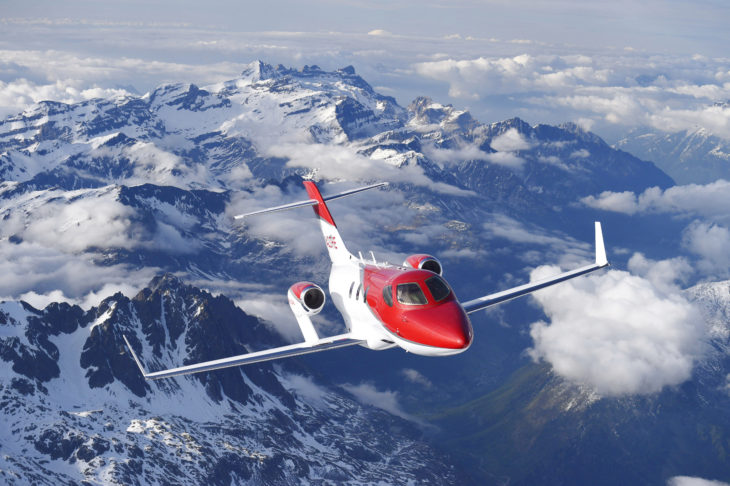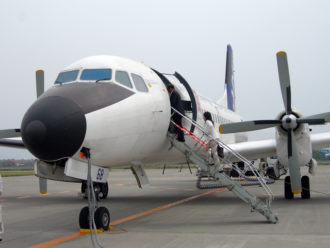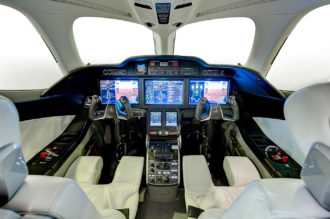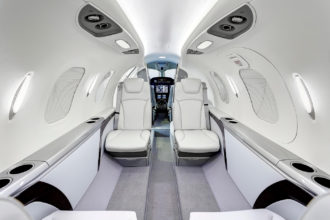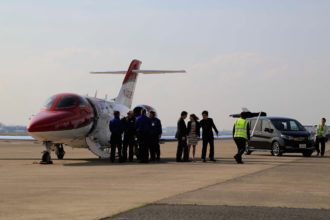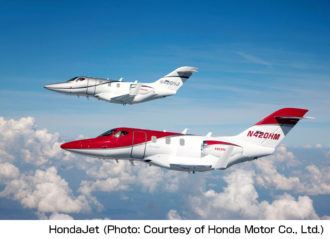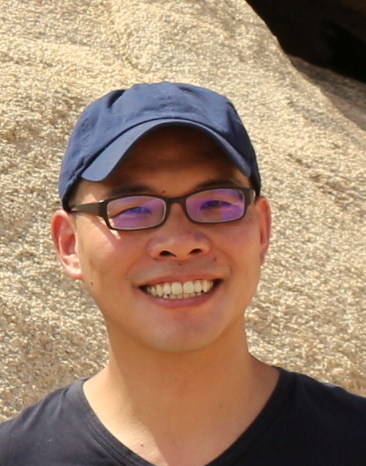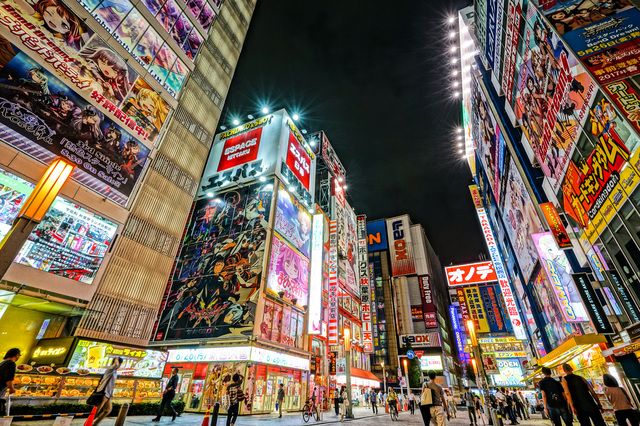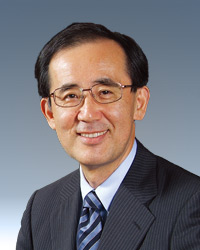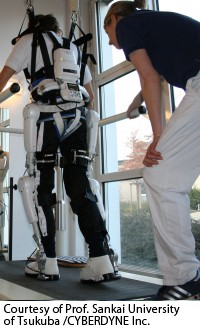The Founder’s Dreams and Engineering Spirit that Sent the HondaJet Soaring
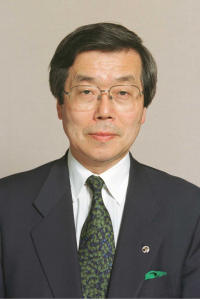
Kojima Akira
Flying smoothly, the HondaJet manufactured by Honda Aircraft Company, a US subsidiary of Honda, is putting the dreams of Honda Soichiro (1906–1991), the founder of Honda, into the air. Mass production began after obtaining type certification for safety from the Federal Aviation Administration (FAA) in December 2015. Orders for in excess of one hundred aircraft have already been logged with forty-three units delivered worldwide in 2017, overtaking the Citation M2, the principal aircraft made by Cessna, to become the international top-seller in the small jet category (weighing less than 5.7 tons). Orders remain steady at the start of 2018 and the speed of production continues to accelerate.
The aircraft is popular for its unprecedented and unique design, which features an over-the-wing engine mount that reduces air resistance and increases fuel efficiency by as much as twenty percent compared to the competition. It is also noted for the quiet and spacious interior of the plane. With a cruising altitude of 43,000 feet and unparalleled performance at altitude, the HondaJet is able to fly higher than the crowded airspace between 30,000 and 39,000 feet where ordinary aircraft fly.
The oldest son of a father who ran a small blacksmith’s business, Soichiro only completed elementary education before getting his first job at a bicycle repair shop, but he held on to his big dreams and today he personifies the success story behind the creation of Honda, a company that is known everywhere. As a child, he was endlessly fond of machines. His first obsession was automobiles, which were rarely seen in the poor village where he lived. The young Soichiro would run through the village desperately chasing after the cars, and dreaming of one day building one himself. In 1915 and 1916, a succession of American stunt fliers visited Japan where they became very popular. The young Soichiro rode his bicycle on unpaved roads for more than twenty kilometers to the venue where the stunt fliers were performing. Unable to afford the entrance fee, he clung to a pine tree outside the venue watching the fliers and promptly developing a passion for airplanes. As of this time, the yearning for automobiles and the skies became in Soichiro’s own words, “a passionate hope, and an ardent wish that colored my whole life.”
Nurtured in this way, the dreams of the young Soichiro became associated with challenging and winning international motorcycle and motorcar races. Soichiro’s dreams also extended to manufacturing aircraft. In 1962, he announced to all Honda employees that the company would embark on developing and building airplanes. In the same year, the Asahi shimbun newspaper organized a light aircraft design contest with the support and participation of Honda. The following year, a number of extremely talented people from among the competition participants joined Honda as employees. One of them was Yoshino Hiroyuki who had studied aeronautical engineering at the University of Tokyo. Thirty-five years later, Yoshino became the fifth president of Honda and went ahead with the development of the HondaJet. Kawamoto Nobuhiko, a precision engineering graduate of Tohoku University, who was to become the fourth president of Honda, also joined the company in the same period as Yoshino. Kawamoto was head of Honda R&D Co., Ltd. (a Honda subsidiary) when Honda decided to start to research and develop aircraft.
Both men were airplane enthusiasts and joined Honda when they found out that the company was about to start developing aircraft. Originally, the precision engineering department at Tohoku University where Kawamoto studied had been the aeronautics department, but the name had been changed by order of the General Headquarters of the Supreme Commander for the Allied Powers (GHQ).
In international terms, Japan’s aircraft industry got off to a late start. The reasons were Japan’s defeat in the Second World War and the so-called seven-year blank (nananen no kuhaku) when GHQ imposed a ban on the production of aircraft. Prewar Japan had produced technically advanced planes such as the famous Zero, the Shiden-kai, and the Saiun—earning Japan the moniker “the kingdom of airplanes.” At its wartime peak, the huge industry produced 24,000 planes a year and employed more than a million people. However, with the postwar ban, airplane engineers lost their workplaces and, as a result, numerous human resources flowed into the automotive industry, contributing much to the subsequent improvement in the quality of automobiles.
The ban on aviation was lifted in 1952, but the seven years of enforced inactivity had had a major impact on the airplane industry in Japan. After the ban was lifted, the Japanese government led a collaboration between universities, industry, and government that started to work on the YS-11, the first passenger jet produced in Japan in the postwar era. Despite the exertions of the engineers manufacturing the plane, the business made huge losses after the maiden flight in 1962 and ceased operations after producing only around 180 aircraft over a period of ten years.
The government was the biggest shareholder of YS-11 and Nihon Aircraft Manufacturing Corporation, established by Mitsubishi Heavy Industries and other private sector corporations, was the main manufacturer. It was a nationwide consortium of the private and public sectors, but the organization was a mishmash put together by bureaucrats with far too much influence, but no knowledge of business. As it turned out, there were limits to the benevolence of the government. The YX concept, a Japan-wide initiative by bureaucrats to develop the next-generation aircraft, also failed.
Instead, joint development with Boeing in the United States was set in motion, but in the shape of Japanese corporations subcontracted to Boeing. Most of the development and production of planes for the Self-Defense Forces was also limited to licensed production of US military aircraft.
Due to the trauma of the YS-11 failure, government-led civilian aircraft projects never resurfaced. Private-sector corporations also recoiled from the huge risks associated with the challenge so Japan’s aircraft industry remained stagnant.
This was the situation when Honda started to research fuselages and engines in 1986 and officially launched the HondaJet program in 1997. The context was Soichiro’s dream to build aircraft and the dreams of the engineers who had converged on Honda. Incidentally, until now, all presidents of Honda have been engineers.
Officially launched in 1997, the HondaJet project has several major characteristics. Firstly, the project is neither a nationwide consortium nor one that depends on funding by the government; rather, it is an independent project undertaken by a single automotive company. This is unlike the YS-11 project. Secondly, the whole project from research and development to production has been implemented in the United States, which is the largest market for business jets. Thirdly, an automotive maker has been responsible for the entire project including engine development. There are hardly any examples anywhere of automotive manufacturers participating in the aircraft industry and no maker has ever been single-handedly responsible for developing and building both the fuselage and the engine for an aircraft at their own expense. For these reasons, HondaJet has attracted attention around the world. Fourthly, the development and production activities in the United States have expanded to involve 1,800 engineers from thirty nations. Some people refer to the HondaJet as the “Hinomaru Jet,” but it is in fact the exact opposite—a project characterized by a global, multinational outlook.
After all, the United States is the main battleground for international business jets. According to research by the Japan Business Aviation Association, there are currently a total of around 21,000 small turbine aircraft (business jets with turbo-propeller engines) flying internationally (2011). The United States accounts for approximately seventy percent of ownership and approximately fifty percent of the annual shipment value. There are roughly 3,000 airports in the United States. Since eighty percent of the population can access an airport within thirty minutes by car, small aircraft are a familiar mode of transportation for many people.
Another important factor is that due to the seven-year postwar ban on aviation activity, the Japanese government (the Civil Aviation Bureau at the Ministry of Land, Infrastructure, Transport and Tourism) does not have sufficient technical ability to certify aircraft. Certification by the FAA and the European Aviation Safety Agency (EASA)—the two big players in both aircraft engines and aircraft—is authoritative and when an aircraft is certified and obtains the type certification, aviation agencies in other countries normally issue equivalent type certificates after some formalities are completed. In addition, since the United States is far better prepared with the equipment and facilities required for the full range of technical tests and trials during the development stages, the strategy was to establish the hub for the HondaJet in the United States from the start. Although there are differences between small aircraft and passenger planes, this is all in stark contrast to the struggling MRJ, the first passenger jet developed by Mitsubishi Heavy Industries, which is yet to take off after repeatedly postponing the delivery of its first aircraft.
The FAA safety standards are, of course, extremely strict and to obtain type certification you have to clear some very high hurdles. I got a strong sense of what is involved when I heard what Fujino Michimasa, the CEO of Honda Aircraft Company in Greensboro, North Carolina, with overall responsibility for the HondaJet development, had to say in June 2017.
An aircraft enthusiast since his youth, Fujino is also a graduate of the aeronautical engineering program at the University of Tokyo. He joined Honda in 1984 and two years later started to work in aviation research and development. In 2012, Fujino was awarded the Aircraft Design Award of the American Institute of Aeronautics and Astronautics (AIAA), and in 2013 the SAE International Clarence L (Kelly) Johnson Aerospace Vehicle Design and Development Award by the SAE, an academic society in the United States. He is the first Japanese to receive this honor. In addition, in 2014, the International Council of the Aeronautical Sciences (ICAS) presented Fujino with its biennial Zhukovsky Award for innovation in aeronautics. All three awards were presented for the same reasons: the unique over-the-wing engine mount to reduce air resistance generated when flying at altitude, innovative technology development such as the natural laminar flow wing, and delivering in the HondaJet the highest level of cruising speed for its class, fuel efficiency, and a spacious passenger cabin and cargo hold. Fujino has contributed to the advancement of academic knowledge in aeronautical engineering through the research and development of advanced technologies. He is also the first in the world to receive all three awards.
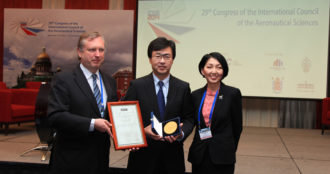
On 11 September 2014, the International Council of the Aeronautical Sciences (ICAS) presented Fujino with its biennial Zhukovsky Award for innovation in aeronautics.
Photo: Courtesy of Honda Motor Co., Ltd.
Pointing out that Honda Aircraft Company had submitted 2.4 million pages of documentation to the FAA, Fujino recollected that, “Everything had to conform to the FAA. Even for someone with experience of aircraft certification, this required an unimaginable amount of work, accuracy, and perseverance. When the FAA absolutely refused to concede on one point, I got so emotional I thought I would explode, but at such times you just have to be patient and try to understand. Since it was such hard work to obtain the certification, I still remember the joy at finally getting it.”
Typically, it is claimed that the total weight of paper including application forms, reports, design specifications and diagrams submitted to the FAA is comparable to the weight of the aircraft fuselage. This would be about four tons in the case of the HondaJet, but ten times as much if applied to the MRJ.
Having already overcome their own cultural and ethnic differences, the 1,800 people on the multinational team at Honda Aircraft Company were overwhelmed by tears and emotion at overcoming such tough hurdles to obtain the FAA certification.
It has also been noted that Honda maintained absolute secrecy about developing the aircraft at its own expense and bypassed Japan from the start to develop the HondaJet in the United States, the biggest battleground in the business. In this sense, Honda is a nonconformist corporation in Japan. By which I mean that Honda went ahead with its own plans for the HondaJet, exchanging hardly any information with the Ministry of Economy, Trade and Industry (METI), which is the governing agency for the aviation industry in Japan. The development was even treated confidentially within Honda for a long time.
In the early 1960s, Honda planned to expand from two-wheeled to four-wheeled vehicles, i.e. from motorcycles to automobiles. At the time, the Ministry of International Trade and Industry (MITI, now METI) was on course to prevent Honda from expanding to the four-wheeled vehicle category. MITI argued that the expansion of the Big Three American automobile manufacturers, including General Motors, to Japan was inevitable and that the Japanese automotive industry would be rendered helpless when they did. MITI wanted to restructure and integrate the flood of automotive manufacturers into two or three companies according to the type of vehicles. Since Honda was the latest entrant to the market for four-wheeled vehicles, there would be no leeway for the company if such a policy were implemented. Exasperated with this policy line, Soichiro marched into the ministry to voice furious objections. Unlike now, MITI held unparalleled power at the time so the resistance attracted attention. We can catch a glimpse of the Honda culture nurtured by the dreams and the entrepreneurial spirit of Soichiro, the founder of Honda, in the response to the challenges presented by the HondaJet.
Today the automotive industry finds itself in a period of historic innovation with the emergence of electric vehicles and automated driving technologies, as well as the increase in the number of corporations entering the automotive industry. The outcome for the worldwide automotive industry is still unclear, but in the HondaJet initiative we find a robust attitude to the pursuit of monozukuri. It is also worth noting that Honda has prioritized the user with the eye-catching design and user-friendliness of the HondaJet.
In this sense, it is possible that the HondaJet will have a broad influence on the future of the international monozukuri industry as well as policies for industry, science, and technology around the world.
Translated from an original article in Japanese written for Discuss Japan. [March 2017]
